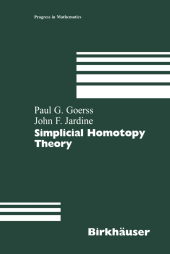 Neuerscheinungen 2012Stand: 2020-01-07 |
Schnellsuche
ISBN/Stichwort/Autor
|
Herderstraße 10
10625 Berlin
Tel.: 030 315 714 16
Fax 030 315 714 14
info@buchspektrum.de |

Paul G. Goerss, John F. Jardine
(Beteiligte)
Simplicial Homotopy Theory
Softcover reprint of the original 1st ed. 1999. 2012. xv, 510 S. XV, 510 p. 235 mm
Verlag/Jahr: SPRINGER, BASEL; BIRKHÄUSER BASEL 2012
ISBN: 3-03-489737-5 (3034897375)
Neue ISBN: 978-3-03-489737-2 (9783034897372)
Preis und Lieferzeit: Bitte klicken
Since the beginning of the modern era of algebraic topology, simplicial
methods have been used systematically and effectively for both computation and basic theory. With the development of Quillen´s concept of a closed model category and, in particular, a simplicial model category, this collection of methods has become the primary way to describe non-abelian homological algebra and to address homotopy-theoretical issues in a variety of fields, including algebraic K-theory. This book supplies a modern exposition of these ideas, emphasizing model category theoretical techniques.
Discussed here are the homotopy theory of simplicial sets, and other basic
topics such as simplicial groups, Postnikov towers, and bisimplicial sets.
The more advanced material includes homotopy limits and colimits,
localization with respect to a map and with respect to a homology theory,
cosimplicial spaces, and homotopy coherence. Interspersed throughout are
many results and ideas well-known to experts, but uncollected in the
literature.
Intended for second-year graduate students and beyond, this book introduces many of the basic tools of modern homotopy theory. An extensive background in topology is not assumed.
I Simplicial sets.- 1. Basic definitions.- 2. Realization.- 3. Kan complexes.- 4. Anodyne extensions.- 5. Function complexes.- 6. Simplicial homotopy.- 7. Simplicial homotopy groups.- 8. Fundamental groupoid.- 9. Categories of fibrant objects.- 10. Minimal fibrations.- 11. The closed model structure.- II Model Categories.- 1. Homotopical algebra.- 2. Simplicial categories.- 3. Simplicial model categories.- 4. The existence of simplicial model category structures.- 5. Examples of simplicial model categories.- 6. A generalization of Theorem 4.1.- 7. Quillen´s total derived functor theorem.- 8. Homotopy cartesian diagrams.- III Classical results and constructions.- 1. The fundamental groupoid, revisited.- 2. Simplicial abelian groups.- 3. The Hurewicz map.- 4. The Ex? functor.- 5. The Kan suspension.- IV Bisimplicial sets.- 1. Bisimplicial sets: first properties.- 2. Bisimplicial abelian groups.- 2.1. The translation object.- 2.2. The generalized Eilenberg-Zilber theorem.- 3. Closed model structures for bisimplicial sets.- 3.1. The Bousfield-Kan structure.- 3.2. The Reedy structure.- 3.3. The Moerdijk structure.- 4. The Bousfield-Friedlander theorem.- 5. Theorem B and group completion.- 5.1. The Serre spectral sequence.- 5.2. Theorem B.- 5.3. The group completion theorem.- V Simplicial groups.- 1. Skeleta.- 2. Principal fibrations I: simplicial G-spaces.- 3. Principal fibrations II: classifications.- 4. Universal cocycles and
$$ \bar W $$G.- 5. The loop group construction.- 6. Reduced simplicial sets, Milnor´s FK-construction.- 7. Simplicial groupoids.- VI The homotopy theory of towers.- 1. A model category structure for towers of spaces.- 2. The spectral sequence of a tower of fibrations.- 3. Postnikov towers.- 4. Local coefficients and equivariant cohomology.- 5. On k-invariants.- 6. Nilpotent spaces.- VII Reedy model categories.- 1. Decomposition of simplicial objects.- 2. Reedy model category structures.- 3. Geometric realization.- 4. Cosimplicial spaces.- VIII Cosimplicial spaces: applications.- 1. The homotopy spectral sequence of a cosimplicial space.- 2. Homotopy inverse limits.- 3. Completions.- 4. Obstruction theory.- IX Simplicial functors and homotopy coherence.- 1. Simplicial functors.- 2. The Dwyer-Kan theorem.- 3. Homotopy coherence.- 3.1. Classical homotopy coherence.- 3.2. Homotopy coherence: an expanded version.- 3.3. Lax functors.- 3.4. The Grothendieck construction.- 4. Realization theorems.- X Localization.- 1. Localization with respect to a map.- 2. The closed model category structure.- 3. Bousfield localization.- 4. A model for the stable homotopy category.- References.


